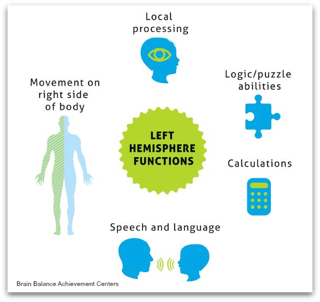Children with a Strong Left Brain Function Typically Perform Well Academically But May Struggle Socially and Behaviorally.
Our brains consist of two sides or hemispheres. Children with behavioral, academic, social, or other challenges often have an imbalance where they predominantly use one side of the brain. This causes one side of the brain to be stronger, while the other side develops more slowly and is weaker.
The left hemisphere of the brain controls learning and information processing. Children who have stronger left-brain functions tend to be more analytical in their thinking and typically perform well academically. They may have a great ability to memorize large amounts of data, have a large vocabulary, and are detail-oriented.
Left-Brained Child: Behavior at Home
If your child’s left hemisphere controls are in charge, you will notice him or her displaying certain traits at home. For example, he or she may like to keep the same routine, such as eating the same foods for breakfast, lunch, and dinner. Left-brained children also appreciate directions and tend to follow directions well.
One of the most noticeable left-brain characteristics is a tidy room. If you rarely tell your child to clean, he or she may have dominant left hemisphere controls. As helpful as this can be at home, you might notice that many left-brained children are not very emotional or super affectionate. They are inclined towards logical thinking instead, and according to Funderstanding, they may often like to spend time alone.
Left-Brained Child: Behavior at School
Parents are not the only people who might notice left-brain characteristics in children. Teachers often notice characteristics too, based on how left-brained children behave in school. The good news is that according to Psychology Today, schools usually cater to left-brained children since most classes require good analytical skills. Children with a strong left brain and a less mature right brain may excel in these areas:
- Science
- Details
- Memorization
- Setting goals
- Reading directions
- Math
Many of these children prefer to study alone, so ensure your child has a quiet place for homework. In addition, since many left-brained kids tend to do well with lists, make it easy for your child to make as many lists as possible, providing a whiteboard, chalkboard, paper, and writing utensils. Not only will your child be grateful for the help, but he or she will likely find success in school and at home.
How to Use This Information to Help Your Child
If a child has a strong left brain and a less mature right brain, he may experience social difficulties and have little interest in sports or outdoor activities. This imbalance in skills can be tough on kids and parents.
It was once thought that the brain was static, unable to grow or change. But extensive research has shown that the brain remarkably adaptable, able to create new neural pathways in response to stimulus in the environment. This is a branch of science called neuroplasticity.


Enjoy These Articles Related to Brain Function and Development
Tips for Motivating Right-Brain Children to Learn
How to Inspire Creative Thinking in Left-Brain Dominant Children
Why Is My Child Struggling?